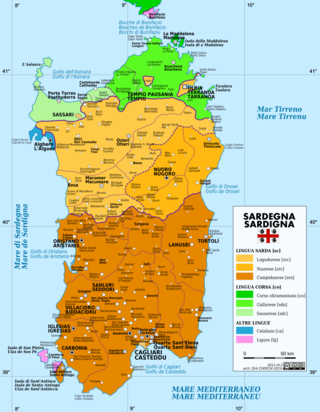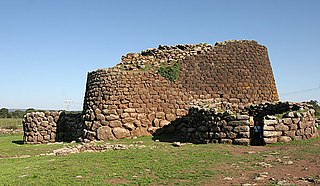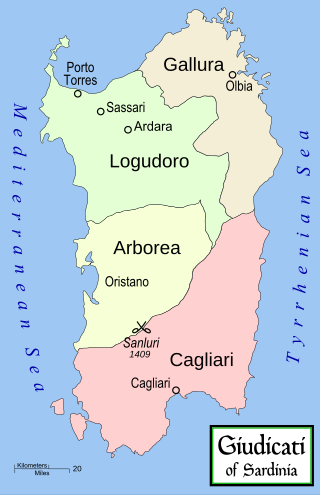
Sardinian or Sard is a Romance language spoken by the Sardinians on the Western Mediterranean island of Sardinia.

Sardinia is the second-largest island in the Mediterranean Sea, after Sicily, and one of the 20 regions of Italy. It is located west of the Italian Peninsula, north of Tunisia and immediately south of the French island of Corsica.

The nuraghe, or also nurhag in English, is the main type of ancient megalithic edifice found in Sardinia, developed during the Nuragic Age between 1900 and 730 B.C. Today it has come to be the symbol of Sardinia and its distinctive culture known as the Nuragic civilization. More than 7,000 nuraghes have been found, though archeologists believe that originally there were more than 10,000.

Cagliari is an Italian municipality and the capital of the island of Sardinia, an autonomous region of Italy. Cagliari's Sardinian name Casteddu means castle. It has about 155,000 inhabitants, while its metropolitan city has more than 431,000 inhabitants. According to Eurostat, the population of the Functional urban area, the commuting zone of Cagliari, rises to 476,975. Cagliari is the 26th largest city in Italy and the largest city on the island of Sardinia.

Archaeological evidence of prehistoric human settlement on the island of Sardinia is present in the form of nuraghes and other prehistoric monuments, which dot the land. The recorded history of Sardinia begins with its contacts with the various people who sought to dominate western Mediterranean trade in Classical Antiquity: Phoenicians, Punics and Romans. Initially under the political and economic alliance with the Phoenician cities, it was partly conquered by Carthage in the late 6th century BC and then entirely by Rome after the First Punic War. The island was included for centuries in the Roman province of Sardinia and Corsica, which would be incorporated into the diocese of Italia suburbicaria in 3rd and 4th centuries.

The Judicates, in English also referred to as Sardinian Kingdoms, Sardinian Judgedoms or Judicatures, were independent states that took power in Sardinia in the Middle Ages, between the ninth and fifteenth centuries. They were sovereign states with summa potestas, each with a ruler called judge, with the powers of a king.

Giovanni Maria Angioy was a Sardinian politician and patriot and is considered to be a national hero by Sardinian nationalists. Although best known for his political activities, Angioy was a university lecturer, a judge for the Reale Udienza, an entrepreneur and a banker.

The Kingdom of Sardinia, also referred to as the Kingdom ofSavoy-Sardinia, Piedmont-Sardinia, or Savoy-Piedmont-Sardinia during the Savoyard period, was a state in Southern Europe from the early 14th until the mid-19th century.

The Nuragic civilization, also known as the Nuragic culture, was a civilization or culture on Sardinia (Italy), the second largest island in the Mediterranean Sea, which lasted from the 18th century BC up to the Roman colonization in 238 BC. Others date the culture as lasting at least until the 2nd century AD and in some areas, namely the Barbagia, to the 6th century AD or possibly even to the 11th century AD.

The Sardinians, or Sards, are a Romance language-speaking ethnic group native to Sardinia, from which the western Mediterranean island and autonomous region of Italy derives its name.

The Perfect Fusion was the 1847 act of the Savoyard king Charles Albert of Sardinia which abolished the administrative differences between the mainland states and the island of Sardinia, in a fashion similar to the Nueva Planta decrees between the Crown of Castile and the realms of the Crown of Aragon between 1707 and 1716 and the Acts of Union between Great Britain and Ireland in 1800.

Sardinian nationalism or also Sardism is a social, cultural and political movement in Sardinia calling for the self-determination of the Sardinian people in a context of national devolution, further autonomy in Italy, or even outright independence from the latter. It also promotes the protection of the island's environment and the preservation of its cultural heritage.
This article presents a history of Cagliari, an Italian municipality and the capital city of the island of Sardinia. The city has been continuously inhabited since at least the neo-lithic period. Due to its strategic location in the Mediterranean and natural harbor, the city was prized and highly sought after by a number of Mediterranean empires and cultures.

The Arzachena culture was a pre-Nuragic culture of the Late Neolithic Age occupying Gallura and part of southern Corsica from approximately the 4th to the 3rd millennium BC. It takes its name from the Sardinian town of Arzachena.
Sardinian banditry is a term which describes an outlaw behavior typical of the Mediterranean island of Sardinia, dating back to the Roman Empire. Twentieth-century Sardinian banditry had economic and political overtones.
Dolores Turchi is an Italian writer.
Anonima sarda is an Italian journalistic expression widely used by the Italian media as an umbrella to describe the Sardinian groups operating kidnappings for ransom, which took place for the most part in the Mediterranean island of Sardinia between the 1960s and 1997.

Sardinia's Day, also known as Sardinian people's Day, is a holiday in Sardinia commemorating the Sardinian Vespers occurring in 1794–96.

The Byzantine age in Sardinian history conventionally begins with the island's reconquest by Justinian I in 534. This ended the Vandal dominion of the island after about 80 years. There was still a substantial continuity with the Roman phase at this time. The invasion of Italy by the Longobards in 568, which changed the face of Italy, only resulted in a few coastal raids on Sardinia.

The 2019 Sardinian regional election took place on 24 February 2019. The election was for all 59 elected seats of the Regional Council of Sardinia as well as the President of the Region who, along with the second placed presidential candidate, would also become members of the Regional Council.













